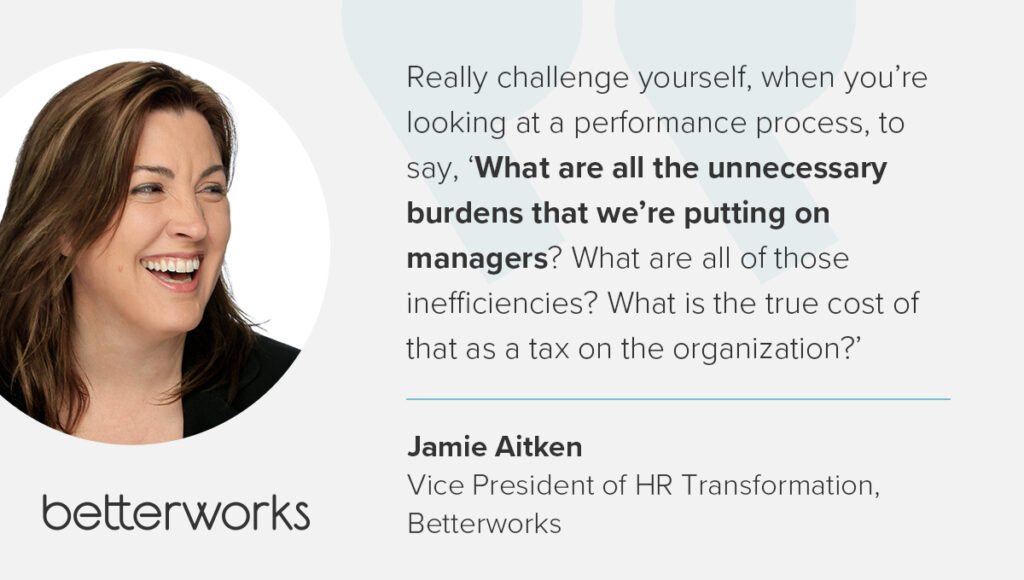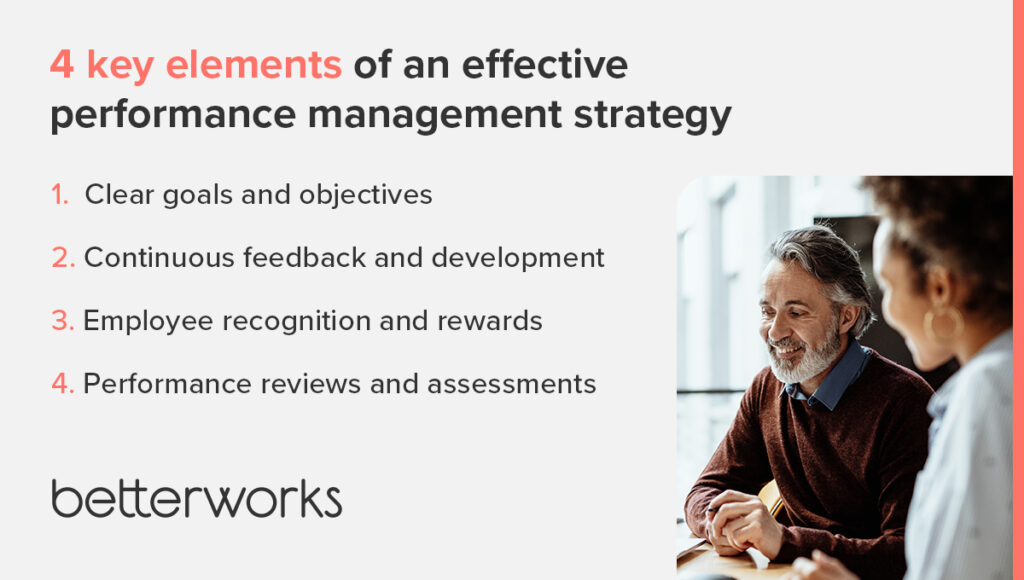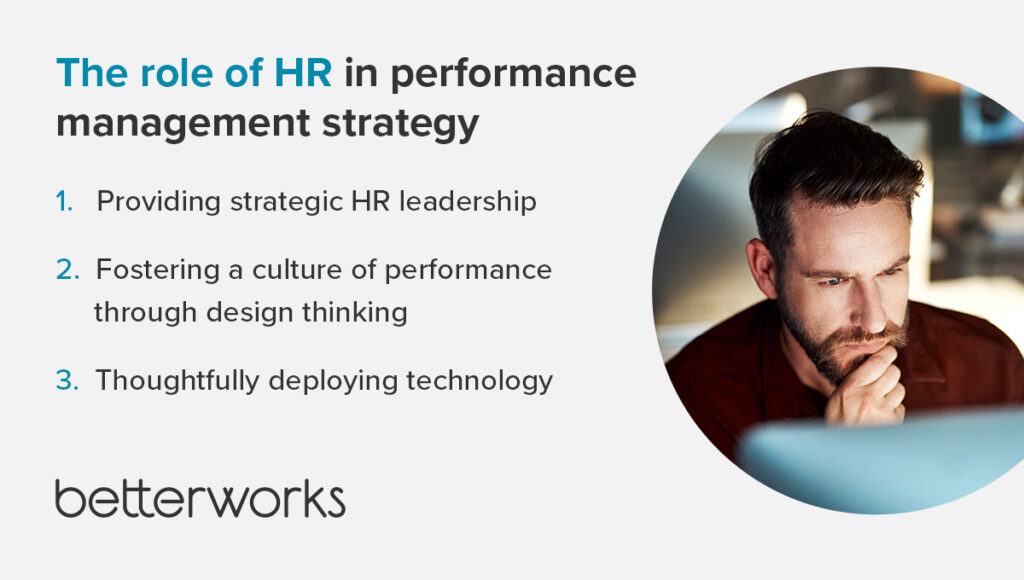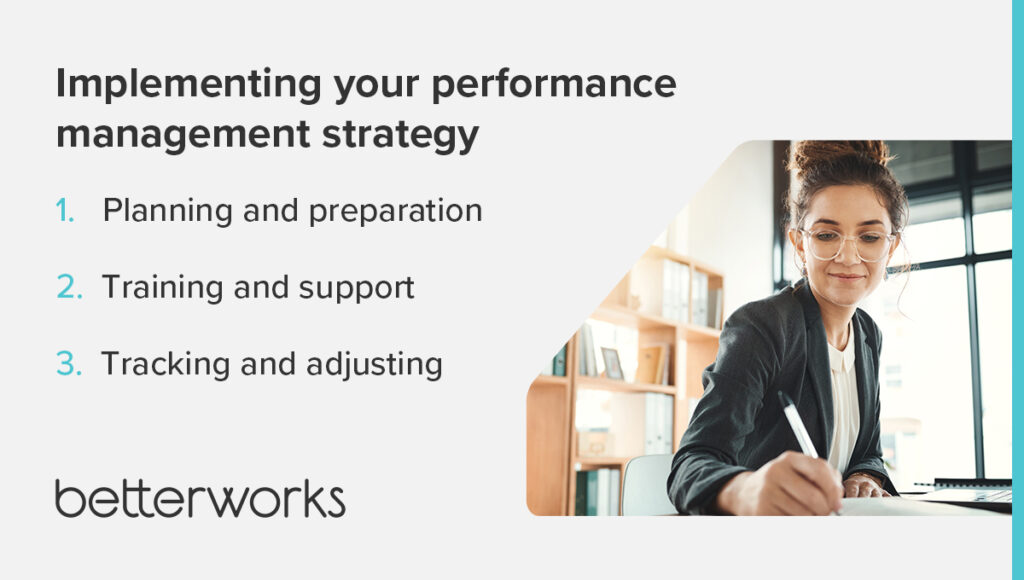Adopting a performance management strategy means taking a critical look at existing practices and setting ambitious goals for improving employee performance that align with your organization’s larger business objectives.
Many business leaders fail to recognize the opportunities inherent in overhauling performance management practices. Merely 12% of executives and HR leaders see existing performance management processes as failing — compared to 44% of employees, according to the 2024 State of Performance Enablement report. Furthermore, 2 in 3 managers report not having the right resources and support to deliver performance management effectively.
“Really challenge yourself, when you’re looking at a performance process, to say, ‘What are all the unnecessary burdens that we’re putting on managers? What are all of those inefficiencies? What is the true cost of that as a tax on the organization?’” says Jamie Aitken, vice president of HR transformation at Betterworks.
If managers and employees perceive performance management as failing, it probably isn’t driving value for the business. But it could: When implemented with the user’s perspective in mind, performance management doesn’t just rate performance — it strengthens your workforce’s ability to create meaningful business value.
Discover how to craft a performance management strategy that enhances employee performance and drives organizational success.
Understanding performance management strategy
Performance management is a strategic tool for driving business outcomes. An intentional performance management strategy aligns employee efforts with the company’s goals, directly contributing to organizational success.
When approached with purpose, every aspect of performance management — from goal setting to feedback — becomes a chance to ensure that your workforce is working toward your company’s strategic vision, enhancing both individual and collective performance.
To illustrate, consider this performance management strategy example: A tech company sets a strategic goal to generate five new product ideas per quarter, with at least one advancing to development. To achieve this, they implement a performance management strategy that encourages cross-department collaboration and continuous learning focused on creativity and problem-solving. Employees are regularly assessed on their contributions to innovation projects, with feedback and rewards tied directly to their impact on the company’s innovation goals.
By aligning individual performance with these objectives, the company fosters a culture of innovation that drives business success.

4 key elements of an effective performance management strategy
A successful strategy for performance management is built on several key elements, each of which plays an essential role in driving quality and excellence across the organization. These elements include setting clear objectives, providing continuous feedback, recognizing and rewarding achievements, and conducting regular performance evaluations. Find out how a strategic approach transforms these elements into a powerful catalyst for business growth.
Clear goals and objectives
A successful performance management strategy begins with clear, high-level objectives that align with your organization’s broader goals. These objectives should focus on how to move the business forward, rather than solely guiding individual employee performance.
Identify the elements of performance management that are driving value and prioritize those. The traditional annual review process could be overburdening managers, for example, without producing any tangible impact on performance outcomes. Ongoing feedback, on the other hand, might be linked to better performance outcomes since employees can course-correct in the flow of work. In this case, you’d consider dropping the dead weight of the annual review and instead invest in systems for empowering ongoing feedback.
Continuous feedback and development
Continuous feedback is a critical component of a performance management strategy, offering specific insights that help employees grow and benefit the organization. When done with purpose, it drives engagement and performance, directly impacting the business’s bottom line.
Coaching feedback in the form of manager-employee conversations should be regular, targeted, and growth-oriented, addressing issues promptly and supporting employee improvement. It should also reinforce positive behaviors, motivating employees to excel. This continuous performance management keeps employees aligned with the company’s goals and fosters ongoing improvement that adds value to the organization.
Employee recognition and rewards
Recognition and rewards are most effective when thoughtfully integrated into your performance management strategy. By linking them to behaviors and outcomes that drive business success, you create a culture that motivates employees and reinforces their value to the organization. This approach makes recognition programs a strategic tool for achieving business goals.
A well-designed recognition program boosts morale, increases job satisfaction, and enhances performance. When employees feel valued, they are more engaged and motivated. For example, tying rewards to specific performance metrics can reinforce desired behaviors, whether through bonuses for meeting targets or non-monetary rewards like peer recognition or extra time off. These practices foster a culture of excellence by aligning rewards with the behaviors that lead to success.
Performance reviews and assessments
Performance reviews should go beyond routine check-ins; they are a strategic opportunity to assess how well employees contribute to the organization’s goals. By focusing on both outcomes and behaviors, reviews can be directly tied to business success, helping to create a workforce that drives the organization forward and reflects its values.
These reviews should ideally be conducted more than once or twice a year. Quarterly reviews can be lightweight and enable both managers and their direct reports to discuss accomplishments, areas for improvement, near-term and longer-term goals, and career development opportunities.
Performance reviews should never surprise employees. If an organization encourages managers and employees to have frequent conversations, performance reviews simply become an assessment of the actions taken as a result of those check-ins, a look forward to how to improve, and the goals tied to those improvements.
When developing prompts and resources for performance appraisals, consider how they align with your overall strategy. For instance, if your organization values innovation, your reviews should evaluate how employees contribute to innovative efforts. This alignment ensures that your performance management strategy supports the organization’s broader goals.

The role of HR in performance management strategy
HR leaders play a pivotal role in designing and implementing performance management strategies that align with organizational goals, improve employee performance, and drive business value.
Providing strategic HR leadership
As an HR leader, you aren’t simply managing processes. Effective HR leadership requires a deep understanding of the organization’s strategic goals and how employee performance can support them. In the past, though, HR leaders have been excluded from these critical conversations. “HR has often not been perceived as a strategic driver, and therefore isn’t even brought into the room when those conversations are happening to identify business objectives,” Jamie says.
To really map performance initiatives to business outcomes, you need to participate in business discussions. “Talent can be deployed to solve business challenges — but you can’t get to that if you’re only having talent discussions once a year in a very heavy bureaucratic process managed by HR,” Jamie says. “It has to be in the moment, in the flow of business.”
Fostering a culture of performance through design thinking
Creating a culture of performance goes beyond implementing processes; it involves intentionally aligning these processes with the organization’s values and goals. By fostering an environment where performance is consistently assessed and rewarded according to business objectives, HR leaders can build a motivated workforce that drives organizational success.
This performance culture thrives on continuous improvement and accountability. Organizations should encourage employees to take ownership of their development, while managers provide regular feedback and support to help them achieve their performance goals.
Culture is fueled by norms and behaviors, so take a design-thinking approach to make sure your performance management process supports the right behaviors. Consider the experience from both the managers’ and employees’ perspectives.
Consider the annual review as an example. An employee may go months without any feedback on performance, and then receive a lot of negative or outdated feedback all at once. “The human experience of that is that it can be very demoralizing, demotivating, discouraging,” Jamie says. “Where design thinking comes into play is actually thinking of those principles first, like an architect, and then moving into, ‘What does this mean in actual steps to the process?’”
Recognizing how the experience impacts outcomes, you can design steps to elicit the behaviors you want to see. If managers give employees regular feedback, for example, employees can apply the feedback to steadily improve. This provides a sense of accomplishment and growth and normalizes feedback so no one feels called out when they receive it.
Thoughtfully deploying technology
Performance management tools can help HR leaders track progress, identify trends, and automate certain aspects of the performance management process. For example, companies can use performance management software to conduct real-time assessments, provide instant manager and peer feedback, and generate detailed reports on performance metrics. This not only saves time but also ensures that your strategy is data-driven and aligned with your organization’s goals.

Implementing your performance management strategy
Successfully implementing a performance management strategy requires careful planning, comprehensive training, and ongoing support. By taking a structured approach to implementation, you can ensure that your strategy is effective and sustainable.
Planning and preparation
Intentionality is most critical in the planning and preparation phase. Start by clearly defining the objectives of your performance management strategy and aligning them with your business goals. This involves collaboration with key stakeholders to ensure everyone is on the same page and that the strategy is designed to support the company’s broader objectives.
For example, if your business goal is to enhance innovation, your performance management strategy should focus on fostering a culture that encourages creative thinking and risk-taking. By aligning your strategy with such goals, you create a framework that drives the business forward rather than just maintaining existing processes.
Training and support
Once your performance management strategy is in place, thorough training and ongoing support are essential. This step is about making sure that managers and employees understand the purpose behind the strategy and how it benefits the organization. Training should cover not only the technical aspects of any tools or processes being used but also the strategic goals that the performance management strategy is designed to achieve.
Ongoing support might include regular check-ins, additional training sessions, or resources that employees can access as needed. The goal is to create a workforce that is not only competent in using the performance management system but also fully invested in the strategic objectives it supports.
Tracking and adjusting
Implementing a performance management strategy is not a one-time event; it requires continuous monitoring and adjusting. Regularly review the effectiveness of your strategy and make changes as needed to keep it aligned with your business goals. This might involve gathering feedback from employees and managers, analyzing performance data, and adjusting goals or processes based on what’s working and what isn’t.
By taking a proactive approach to monitoring and adjusting, you can keep your performance management strategy relevant and effective over time. This continuous improvement process helps to make sure that your strategy is always driving value for the organization.

Final thoughts: developing an effective performance management strategy
A well-crafted strategy aligns employee performance with the company’s strategic objectives, creating a powerful engine for growth and innovation. By setting clear, strategic goals, providing continuous feedback, recognizing achievements, and regularly refining your approach, you empower your employees to perform at their best.
When implemented with intention, performance management becomes a powerful tool for driving business outcomes and achieving your company’s strategic objectives. As an HR leader, it’s your role to shape and refine these processes, ensuring they contribute meaningfully to your organization’s goals.
Want to learn more? Find out how Betterworks customers elevate workforce performance.
Elevate your business with the 6 keys to performance management







